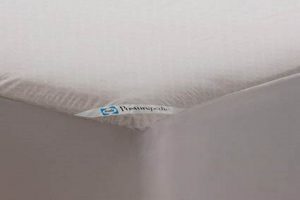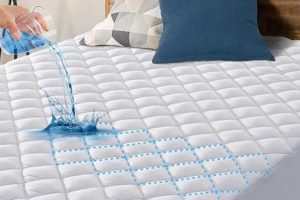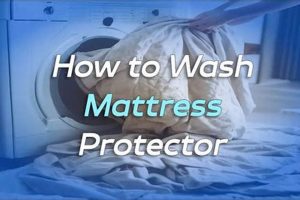A specialized covering designed to shield a bed’s sleeping surface from liquids, particularly urine, is a critical component in maintaining hygiene and extending the lifespan of bedding. These protective layers prevent moisture from penetrating the mattress, thereby thwarting the growth of mold, bacteria, and dust mites. An example includes a waterproof membrane encased in a soft, absorbent fabric, offering a barrier against spills and accidents.
The importance of such protection lies in its ability to preserve the integrity of the mattress, a significant household investment. Benefits include reduced cleaning requirements, allergy mitigation, and increased comfort. Historically, solutions involved less sophisticated methods, whereas modern protectors utilize advanced materials and construction techniques to provide superior performance and discreet protection.
The following sections will delve into the specific materials used in their construction, explore various types available on the market, and discuss best practices for their care and maintenance. Further discussion will address factors to consider when selecting the optimal solution to meet individual needs and circumstances.
Guidance on Usage and Selection
The subsequent recommendations offer practical advice for selecting and utilizing a specialized layer designed to shield mattresses from liquid damage.
Tip 1: Prioritize Waterproofing. Ensure the chosen protector possesses a reliable waterproof membrane. Thermoplastic polyurethane (TPU) is a frequently used material known for its effectiveness in preventing liquid penetration.
Tip 2: Consider Breathability. While waterproofing is essential, breathability is equally important to prevent overheating and promote a comfortable sleeping environment. Look for options with breathable fabrics like cotton or bamboo.
Tip 3: Evaluate Material Composition. Opt for hypoallergenic materials to minimize the risk of allergic reactions. Certifications such as OEKO-TEX Standard 100 indicate that the product has been tested for harmful substances.
Tip 4: Assess Fit and Compatibility. Verify that the protector fits the mattress snugly and securely. Measure the mattress depth accurately to ensure proper coverage and prevent shifting during use.
Tip 5: Implement Proper Care and Maintenance. Follow the manufacturer’s instructions for washing and drying. Regular cleaning will help maintain hygiene and prolong the protector’s lifespan.
Tip 6: Review Warranty Information. Examine the warranty offered by the manufacturer. A comprehensive warranty can provide assurance regarding the product’s durability and performance.
Tip 7: Explore Available Features. Some protectors offer additional features, such as stain resistance or odor control. Consider these features based on individual needs and preferences.
Adhering to these guidelines can significantly enhance the effectiveness of this specific type of mattress protection, ensuring both hygiene and longevity of bedding.
The final section will summarize the key benefits and offer concluding remarks on selecting the most appropriate protective solution.
1. Waterproof Layer
The waterproof layer constitutes a fundamental element of a bed wetting mattress protector. Its primary function is to prevent the passage of liquids, specifically urine, from penetrating the mattress core. This barrier is crucial because urine absorption into the mattress leads to unsanitary conditions, including bacterial growth, unpleasant odors, and eventual degradation of the mattress materials. The effectiveness of a bed wetting mattress protector is directly contingent upon the integrity and impermeability of its waterproof layer. Without a reliable waterproof barrier, the protector fails to fulfill its intended purpose.
Examples of waterproof layers include thermoplastic polyurethane (TPU) films or polyethylene films bonded to fabric. TPU is often preferred due to its flexibility, durability, and breathability compared to other materials. The practical significance of this understanding lies in the selection process: consumers should prioritize protectors that explicitly state the use of a robust waterproof material and provide details regarding its performance characteristics, such as water pressure resistance testing or industry certifications. Failing to scrutinize this aspect may result in purchasing a product that does not adequately safeguard the mattress.
In summary, the waterproof layer is not merely a component of a bed wetting mattress protector, but rather its raison d’tre. Its absence or failure renders the protector ineffective. Challenges arise when manufacturers compromise on material quality or thickness to reduce costs, impacting the protector’s lifespan and overall utility. Therefore, a thorough understanding of the waterproof layer’s properties and its role in safeguarding against liquid damage is essential for making informed purchasing decisions, aligning directly with the overall goal of maintaining a hygienic and durable sleeping environment.
2. Absorbent Material
The absorbent material integrated within a bed wetting mattress protector serves as a crucial intermediary layer between the waterproof backing and the sleep surface. Its primary function is to quickly wick away moisture, preventing it from pooling and creating discomfort for the sleeper. This action minimizes the sensation of wetness and helps to contain the spread of liquid, reducing the area requiring cleaning. The effectiveness of the absorbent material directly influences the overall comfort and usability of the protector, especially during incidents of bed wetting. For instance, materials like cotton terry or bamboo rayon are frequently employed due to their inherent absorbency and softness.
The choice of absorbent material impacts several factors, including the protector’s drying time after a wetting incident and its breathability. Highly absorbent materials reduce the likelihood of liquid seeping past the protector’s edges onto the bedding below. Furthermore, the specific weave and thickness of the fabric contribute to its absorption capacity. Protectors with thicker, more densely woven absorbent layers offer enhanced protection but may also require longer drying times. In practice, materials that readily release moisture during washing are preferred to prevent the build-up of odors and maintain hygiene over repeated use. This is often a balancing act, as higher absorbency can sometimes equate to longer drying times.
In conclusion, the absorbent material within a bed wetting mattress protector is not merely a comfort feature but an essential component that determines its effectiveness in managing moisture and maintaining a sanitary sleeping environment. The selection of appropriate absorbent materials, alongside the waterproof layer, requires careful consideration to achieve optimal performance and durability. The challenge remains in identifying materials that balance absorbency, breathability, and ease of maintenance for prolonged use.
3. Breathable Fabrics
Breathable fabrics play a critical role in the functionality of a bed wetting mattress protector by mitigating the adverse effects associated with non-breathable waterproof barriers. A primary concern with conventional waterproof materials, such as vinyl, is their tendency to trap heat and moisture. This trapped environment fosters discomfort and can lead to increased perspiration, exacerbating skin irritation, and disrupting sleep. Breathable fabrics, in contrast, allow for air circulation, promoting the evaporation of moisture and regulating temperature. The practical effect of this is a cooler, drier sleep surface, enhancing comfort and reducing the likelihood of skin problems. Examples of breathable fabrics used in these protectors include cotton, bamboo rayon, and specialized polyester blends engineered to facilitate airflow.
The integration of breathable fabrics directly addresses the trade-off between waterproof protection and sleep comfort. While a completely impermeable barrier is essential to prevent liquid penetration, it inevitably restricts airflow. By combining a waterproof membrane with a breathable fabric top layer, manufacturers aim to achieve both objectives. For example, a bed wetting mattress protector might feature a TPU (Thermoplastic Polyurethane) waterproof layer laminated to a cotton terry or a moisture-wicking knit fabric. This construction allows for waterproof performance while simultaneously allowing for the passage of air and moisture vapor away from the body. Moreover, the choice of fabric influences the overall feel of the protector. Softer, more pliable breathable fabrics contribute to a more natural sleep surface, minimizing the sensation of sleeping on a synthetic material. This is particularly important for individuals with sensitive skin or those prone to overheating during sleep. The practical implication is improved sleep quality and reduced risk of skin irritation and discomfort.
In summary, breathable fabrics are not merely an optional feature in bed wetting mattress protectors but a necessary component for maximizing comfort and minimizing potential drawbacks. Their ability to regulate temperature and moisture significantly enhances the user experience. The challenge lies in selecting protectors that utilize high-quality, durable breathable fabrics capable of maintaining their performance over repeated washings and prolonged use. Understanding the properties of different breathable fabric options empowers consumers to make informed choices, ultimately contributing to a more comfortable and hygienic sleeping environment.
4. Hypoallergenic Properties
The inclusion of hypoallergenic properties in a bed wetting mattress protector directly addresses the potential for allergic reactions. Bed wetting incidents create a moist environment that can foster the growth of mold, mildew, and dust mites. These allergens, in turn, can trigger or exacerbate allergic reactions and respiratory issues in susceptible individuals. A bed wetting mattress protector constructed with hypoallergenic materials, such as tightly woven fabrics that prevent dust mite penetration or fabrics treated to inhibit microbial growth, mitigates these risks. The cause-and-effect relationship is clear: moisture leads to allergen proliferation, which leads to allergic responses; hypoallergenic materials interrupt this cycle. The importance of this feature lies in creating a healthier sleeping environment, particularly for children and individuals with sensitivities.
Consider, for instance, a child with asthma who experiences nocturnal enuresis. Without a protector offering hypoallergenic features, the child’s exposure to dust mites and mold spores within the mattress increases, potentially triggering asthma attacks or worsening existing respiratory symptoms. In contrast, a protector made from hypoallergenic materials acts as a barrier, preventing allergens from reaching the child and minimizing the risk of respiratory distress. Furthermore, protectors made with certified hypoallergenic materials, such as those with OEKO-TEX Standard 100 certification, provide assurance that the materials have been tested for harmful substances and are less likely to cause skin irritation or allergic contact dermatitis. The practical significance of this understanding is that consumers should actively seek out protectors with explicit claims of hypoallergenic properties and supporting certifications to safeguard the health and well-being of the sleep environment occupants.
In conclusion, hypoallergenic properties are a critical component of bed wetting mattress protectors, serving as a proactive measure to minimize allergen exposure and promote a healthier sleeping environment. The challenge remains in effectively communicating the importance of these features to consumers and ensuring that manufacturers adhere to rigorous standards in the selection and processing of hypoallergenic materials. The integration of such properties is not merely a marketing claim but a fundamental aspect of creating a functional and health-conscious product, directly impacting the quality of sleep and respiratory health of individuals prone to bed wetting incidents.
5. Secure Fit
A secure fit is paramount to the functionality and effectiveness of a bed wetting mattress protector. Its proper application ensures that the protective barrier remains consistently positioned, thereby preventing liquid from reaching the mattress itself. A poorly fitted protector compromises its intended purpose, rendering the mattress vulnerable to damage and unsanitary conditions.
- Elasticized Edges and Corner Straps
Elasticized edges and corner straps are integral to maintaining a secure fit. These features enable the protector to grip the mattress firmly, preventing slippage during movement or sleep. For example, a protector with deep pockets and strong elastic can accommodate thicker mattresses without riding up. Inadequate elastic or poorly designed corner straps can lead to shifting, exposing the mattress to potential soiling.
- Proper Sizing and Mattress Depth
Accurate sizing is essential for a secure fit. A protector that is too small will not adequately cover the mattress, while one that is too large may bunch up and create discomfort. Consideration of mattress depth is also crucial. Deep-pocket protectors are designed to accommodate thicker mattresses, ensuring complete coverage and a snug fit. Failing to select the appropriate size and depth can compromise the protector’s effectiveness.
- Waterproof Barrier Integrity
A secure fit directly impacts the integrity of the waterproof barrier. When a protector shifts or bunches, the waterproof membrane can become stretched or compromised, creating weak points that allow liquid to seep through. Consistent and even tension across the protector surface is necessary to maintain the waterproof barrier’s effectiveness. Movement-induced friction against the mattress without a secure fit can degrade the protector’s waterproof properties.
- Comfort and Noise Reduction
Beyond protection, a secure fit contributes to comfort and noise reduction. A loose or ill-fitting protector can create uncomfortable ridges or crinkling sounds during movement, disrupting sleep. A snug, secure fit minimizes these issues, providing a smoother, quieter sleep surface. This is particularly relevant for individuals sensitive to tactile sensations or noise disturbances during sleep.
These facets underscore the critical role of a secure fit in maximizing the benefits of a bed wetting mattress protector. The choice of a protector should prioritize appropriate sizing, effective elastic components, and design features that ensure consistent and reliable coverage. A compromise in any of these areas diminishes the protector’s overall effectiveness and its ability to safeguard the mattress.
6. Easy Maintenance
Maintaining a bed wetting mattress protector in a clean and hygienic state is essential for its continued effectiveness and the overall health of the sleep environment. The ease with which a protector can be cleaned directly impacts its usability and longevity, and should be a key consideration when selecting a product.
- Machine Washability
Machine washability is a fundamental aspect of easy maintenance. Protectors that can be safely laundered in a standard washing machine simplify the cleaning process. The ability to use conventional detergents and washing cycles without damaging the waterproof layer or other features ensures regular cleaning is convenient and accessible. Protectors requiring specialized cleaning methods, such as hand washing or professional laundering, pose practical challenges and may lead to less frequent cleaning, compromising hygiene.
- Dryer Compatibility
The ability to tumble dry a bed wetting mattress protector is as significant as its washability. Protectors that air dry slowly can prolong the time it takes to put the bed back into service, and may also promote the growth of mold or mildew if not completely dried. Dryer compatibility allows for quick and thorough drying, minimizing downtime and ensuring the protector is ready for immediate reuse. However, it is important to follow manufacturer’s instructions regarding drying temperatures to prevent damage to the waterproof layer or elastic components. High heat can compromise these materials, reducing the protector’s lifespan.
- Stain Resistance
Stain resistance is a desirable feature that contributes to easy maintenance. Protectors with stain-resistant finishes or materials are less likely to retain urine stains, making them easier to clean and maintain a pristine appearance. This reduces the need for aggressive stain removal methods, which can potentially damage the waterproof layer or fabric. The ability to simply blot or lightly scrub away spills simplifies routine cleaning and preserves the protector’s overall condition.
- Material Durability
The durability of the protector’s materials is directly linked to its ease of maintenance. Protectors constructed from robust, high-quality materials are better able to withstand repeated washing and drying cycles without significant degradation. Flimsy materials may tear, shrink, or lose their waterproof properties over time, requiring more frequent replacements and negating the benefits of easy maintenance. Opting for protectors with reinforced seams, durable elastic, and high-quality fabrics ensures they can withstand the rigors of regular cleaning without compromising their protective function.
In conclusion, easy maintenance is not merely a convenience, but a critical factor in ensuring the long-term effectiveness and hygiene of a bed wetting mattress protector. Machine washability, dryer compatibility, stain resistance, and material durability collectively contribute to a product that is simple to clean and maintain, promoting a healthier and more sanitary sleep environment.
7. Durability
Durability represents a critical attribute of any effective bed wetting mattress protector. It dictates the protector’s capacity to withstand repeated use, cleaning cycles, and exposure to moisture without compromising its protective capabilities. The longevity of a mattress protector directly correlates to its ability to safeguard the underlying mattress from liquids and allergens, making durability a prime consideration for purchasers.
- Material Composition and Weave Density
The inherent strength and resilience of the materials used in construction significantly influence durability. High-quality fabrics, such as tightly woven cotton blends or specialized synthetic materials, offer greater resistance to tearing, abrasion, and degradation from exposure to urine. For example, a protector constructed from a tightly woven polyester fabric with a laminated thermoplastic polyurethane (TPU) membrane will generally exhibit greater durability compared to one made from thinner, less robust materials. The weave density directly affects the fabric’s ability to withstand stress and maintain its integrity over time.
- Waterproof Membrane Integrity
The waterproof membrane is the core of the protector’s function. The durability of this membrane is crucial, as any compromise in its integrity renders the protector ineffective. Materials like TPU are known for their flexibility and resistance to cracking or peeling, even after repeated washing and drying cycles. Cheaper alternatives may be more prone to failure, leading to leaks and requiring premature replacement. The method of adhering the waterproof membrane to the fabric also plays a role; lamination typically provides a more durable bond compared to coatings.
- Seam Strength and Reinforcement
The seams of a bed wetting mattress protector are often points of stress, particularly during washing and use. Reinforcing seams with durable stitching and binding enhances their ability to withstand tension and prevent tearing. A protector with poorly constructed seams is more likely to fail prematurely, allowing liquids to seep through and compromise the mattress. Double-stitched or reinforced seams are indicative of a higher-quality, more durable product.
- Resistance to Degradation from Cleaning Agents
The ability of a bed wetting mattress protector to withstand repeated exposure to cleaning agents without significant degradation is a key aspect of its durability. Harsh detergents and bleach can break down fabric fibers and compromise the waterproof membrane, reducing the protector’s lifespan. Protectors made from materials resistant to these chemicals will maintain their protective properties for a longer period. Following the manufacturer’s instructions regarding cleaning methods and detergent types is essential to maximizing the protector’s durability.
In summation, the durability of a bed wetting mattress protector is a multifactorial attribute dependent on material quality, construction techniques, and resistance to environmental factors. Selecting a protector with a focus on these facets ensures a longer lifespan, sustained protection for the mattress, and a more cost-effective solution in the long term. Compromising on durability can lead to frequent replacements, increased expense, and a heightened risk of mattress damage.
Frequently Asked Questions
This section addresses common inquiries regarding bed wetting mattress protectors, providing essential information for informed decision-making.
Question 1: What constitutes an effective bed wetting mattress protector?
An effective bed wetting mattress protector incorporates a waterproof barrier, absorbent layer, breathable fabric, hypoallergenic properties, a secure fit, and easy maintenance features. Durability of materials is also paramount.
Question 2: How frequently should a bed wetting mattress protector be cleaned?
A bed wetting mattress protector requires cleaning after each incident of wetting. Regular washing, approximately every one to two weeks, is also recommended to maintain hygiene and eliminate allergens.
Question 3: What materials are optimal for a bed wetting mattress protector?
Optimal materials include thermoplastic polyurethane (TPU) for waterproofing, cotton or bamboo for absorbency, and breathable fabrics like specialized polyester blends. Hypoallergenic options are also advisable.
Question 4: Can a bed wetting mattress protector completely prevent mattress staining and odor?
A bed wetting mattress protector significantly reduces the risk of mattress staining and odor. However, prompt cleaning following a wetting incident is crucial for preventing long-term issues. Complete prevention cannot be guaranteed in all circumstances.
Question 5: Are all bed wetting mattress protectors suitable for individuals with allergies?
Not all bed wetting mattress protectors are hypoallergenic. Protectors labeled as hypoallergenic and certified by organizations such as OEKO-TEX are specifically designed to minimize allergic reactions.
Question 6: How does one ensure a proper fit when selecting a bed wetting mattress protector?
To ensure a proper fit, measure the mattress depth accurately and choose a protector with deep pockets and elasticized edges. The protector should fit snugly without bunching or shifting.
Proper selection and maintenance of a bed wetting mattress protector are vital for preserving mattress integrity and promoting a hygienic sleep environment.
The subsequent section will delve into the economic considerations associated with purchasing and maintaining bed wetting mattress protectors.
Conclusion
The preceding analysis has explored the various facets of a bed wetting mattress protector, underscoring its significance in maintaining a hygienic and durable sleep environment. Key attributes such as waterproof integrity, absorbent capacity, breathability, hypoallergenic composition, secure fit, and ease of maintenance have been detailed, along with the critical role of material quality and construction in determining long-term efficacy. Selection of a suitable protector requires careful consideration of individual needs and circumstances, factoring in mattress dimensions, sensitivity to allergens, and preferred cleaning methods. A properly chosen and maintained protector mitigates the adverse effects of nocturnal enuresis, safeguarding the mattress investment and promoting restful sleep.
The ongoing refinement of materials and manufacturing techniques promises further enhancements in the performance and longevity of these protective products. Continued research into innovative fabric technologies and waterproof barriers will undoubtedly contribute to more effective and comfortable solutions for individuals managing bed wetting. The diligent application of the outlined information will empower consumers to make informed decisions, ultimately promoting improved sleep quality and bedding preservation.


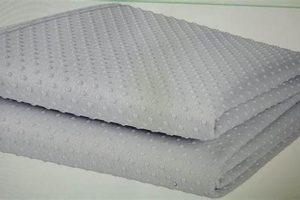
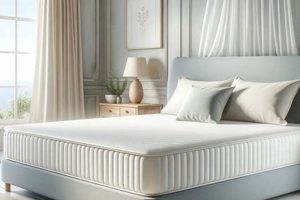
![Cool Tempur-Pedic Comfort: Cooling Mattress Protector [Guide] Organic & Natural Mattress Buyer’s Guide: Non-Toxic Sleep Solutions Cool Tempur-Pedic Comfort: Cooling Mattress Protector [Guide] | Organic & Natural Mattress Buyer’s Guide: Non-Toxic Sleep Solutions](https://mattressworldpa.com/wp-content/uploads/2025/07/th-2523-300x200.jpg)
